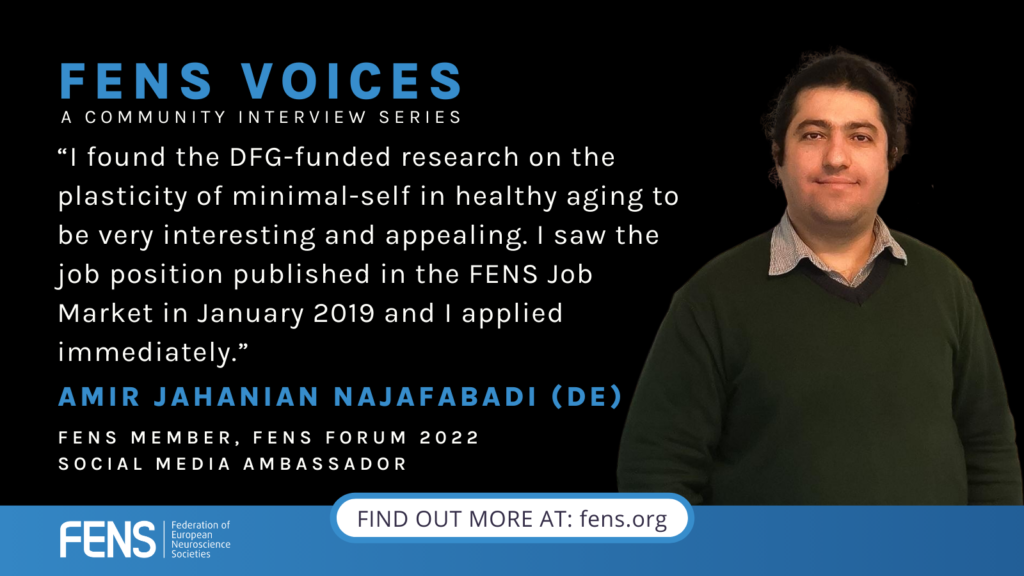
FENS Voices | Amir Jahanian Najafabadi: AI neuroscience and personalised treatments
12 May 2023
FENS News, Neuroscience News
FENS Voices reconnected with FENS Forum 2022 Social Media Ambassador Dr Amir Jahanian Najafabadi, to find out about his recent work and experience at last year’s Forum. Amir is a postdoctoral researcher in interdisciplinary neuroscience in the Department of Cognitive Neuroscience at Bielefeld University (DE), working alongside Prof. Christoph Kayser. Amir received his BSc in Psychology and Children with Special Needs and his MSc degree in Educational Psychology from Shiraz University (IR). In 2019, he became a research associate in Neuroscience at Constructor University (previously Jacobs University Bremen) where he later received his PhD degree. He studied the plasticity of minimal-self in healthy aging to understand how virtual and real-life changes in sensorimotor experiences shape the perception of body ownership, agency and location using neurobehavioral measurements. Amir is also studying how long-term motor experiences with specific tools in athletes (e.g., golfers) alter body schema, body ownership, sense of agency and peripersonal space. For the latter, he uses brain-computer interfaces and brain training-related methods in neuroscience to develop individualised therapeutic protocols for clinical patients and peak performance purposes in healthy individuals. In addition to a decade of broad clinical and research experiences, he has been teaching students, medical professionals and psychologists. Read the full interview below.
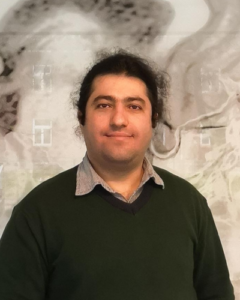
You hold a Master’s in Educational Psychology with a specialisation in special needs children. How did you get involved in this area?
AJN: I’ve been very curious about interpersonal relationships ever since I was in primary school and also about what drives people towards abnormal behavior in their daily lives. Observing the difficulties faced by the ones around me and what they experienced during school time was enough to encourage me to think about my future career and core interest. Back then, I asked myself two major questions. First, do certain people learn behaviours during maladaptive development, or in a different manner compared to the majority? Secondly, do teachers or parents play a significant role or do they negatively impact this learning process? These questions were raised following personal experiences during my school time (both positive and negative). Later, at the beginning of high school (nearly 20 years ago), I found out coincidentally that my passion and curiosity to answer such questions can be pursued through a major called psychology. However, having had no prior knowledge regarding this direction, neuroscience and brain research weren’t so far away from my core interest, as I never thought that the brain and psychology can be at least partially distinguished. In this line, I remember telling myself and my mother that I wanted to be a researcher in this field with the goal to help people through scientific discoveries. My parents supported me immensely throughout this journey to this very day.
I started to study psychological theories on my own, in parallel with my high school courses, and I increased my knowledge in the field. I wanted to make sure that I really liked it enough to follow it as my major, so that I can pass the entrance exam to enroll in a psychology program at the university. I chose to major in the psychology of children with special needs rather than clinical psychology. One reason was that I had seen a few of my peers suffering from learning disabilities and ADHD in classes and getting lower grades or being beaten up by teachers because of having poor academic performance, despite being very smart and active students in other disciplines. My impression and understanding were that my country had not only a need to provide direct support but also to educate parents and teachers. This later drove me to educate teachers starting from the end of my bachelor’s, when I became a teacher for continued education in different states of Iran, my home country. The more knowledge and experience I gained in this field, the more I felt encouraged to publish. So, I printed a few books, booklets, and handouts in layman’s language for parents and teachers so that they can help children step by step when needed. As I believed in mentorship back then, I followed up with some of the schools in rural areas that had less access to the professional sectors or were extremely far away from any health centers, which would allow them to meet psychiatrists or psychologists. I found this extremely encouraging. It motivated me to invest more in this path, by making it more interdisciplinary with neuroscience, learning neuropsychological and neuroscientific methods and by taking advanced courses supported financially by my family. It has been a wonderful journey and as I am talking with you now, I can say that I achieved a few of my goals and that I am glad for the choices and the efforts that I have made, which makes me feel very satisfied.
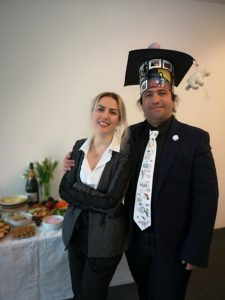
In 2018 you obtained a certificate in Clinical Neuroscience and Psychology at the Faculty of Psychology and Medicine from Porto (PT). Your wife is a researcher in neuroscience as well and she joined you in Portugal, where she also pursued research. You have now been working together for 13 years. How has this joint neuroscience journey been for you both?
AJN: We started our journey following a few courses in other European countries where we advanced our knowledge in neuroscience and neuropsychology. Although we were engaged in neuroscientific research while we were living in Iran, we both needed to leave our clinical work behind and come to Europe in order to further develop ourselves by completing complex neuroscientific studies and by getting familiar with the standards of expert scientists. Then later, in 2016, in the beautiful city of Porto, we enrolled in a neuroscience and psychology PhD programme. In parallel, we continued our neurotherapy and neuropsychological rehabilitation work in a neuropsychiatric clinic there. We found the invitation and the opportunity to work within a multidisciplinary team very appealing. This encouraged us to take the offer.
It was a fantastic experience. We became more international and we adapted to European cultures and particularly Portuguese culture.
How was studying in Iran different from studying in Europe?
AJN: This is not an easy question to answer, especially talking about it right now. During the last years, with the support of a group of advanced neuroscientists and neurologists who also mostly graduated abroad, we benefited from an incredible development in neuroscientific studies in Iran. However, going back to the moment when we decided to move abroad and also now, I would say that there are several advantages to studying neuroscience in Europe compared to my home country. In Europe, we get access to scientific publications or materials without risking sanctions or barriers, which is the first step to studying recent developments in a given field. Another difference and advantage is that in Europe neuroscience is not as new as it is in Iran and it is far more advanced and developed towards an interdisciplinary perspective instead of having only the clinical perspective. Additionally, the easy access to advanced laboratories from different universities/countries and the step-by-step mentorship is also a big advantage, especially when these are free of charge or come with financial support provided by institutions or various projects. Since we have the privilege of gaining knowledge and expertise from generous scientists, my wife and I have been supervising several Master’s and PhD students enrolled in neuroscience programs in Iran who are willing to deepen their knowledge to develop themselves within this field and help out people in their region.
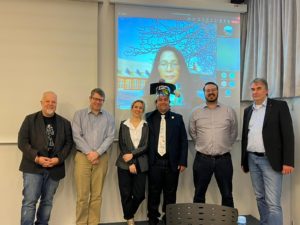 You later became a research associate in Interdisciplinary Neuroscience at Constructor University (DE). Why did you decide to move to Germany and dedicate your research to Interdisciplinary Neuroscience?
You later became a research associate in Interdisciplinary Neuroscience at Constructor University (DE). Why did you decide to move to Germany and dedicate your research to Interdisciplinary Neuroscience?
AJN: My previous longitudinal research experience in developmental neuroscience at the Norwegian laboratory (Nu-lab) at the Norwegian University of Science and Technology (NTNU) on “looming and visual motion perception in preterm and full-term born babies” attracted me to shift a bit from a purely clinical interest to interdisciplinary and multidimensional studies. I was highly encouraged to get deeper into basic neuroscientific research that either can be implemented for diagnostic purposes or applications in future clinical cases. This is how I found the German Research Foundation (DFG)-funded research on the “plasticity of minimal-self in healthy aging” to be very interesting and appealing, as a complex interdisciplinary study through which I can improve my theoretical, technical and practical knowledge in the field. Therefore, I gladly applied and worked on it for nearly four years and I continue working with the team of PIs to further share our findings with the scientific community. Currently, my interests are to continue to study body representation, body perception, multisensory processing, and sensorimotor learning. I am willing to continue developing this line of research to translate findings for both healthy people and patients later on. One interesting fact about my PhD research project is that I saw the job position published in the FENS Job Market in January 2019 and I applied immediately!
How do virtual and real-life changes in sensorimotor experiences shape the perception of body ownership, agency and location?
AJN: I can briefly answer using the findings of our study which employed a virtual tool-use paradigm. We found that younger adults incorporate virtual tools into their existing body schema while body schema in older adults is less plastic, as they did not alter during the training. We also found that the emergence of a sense of body ownership in younger adults during virtual tool-use training is associated with an altered body schema while the plasticity of the forearm body schema does not predict a sense of ownership and agency in older adults. To address further questions, we are looking at other datasets from neurobehavioral measurements conducted during our studies. For example, we discovered that both younger and older adults benefit more from integrating visual and haptic feedback and multisensory processing learning faster and better during the virtual tool-use training compared to only virtual tool-use training with visual feedback. We continued to investigate whether resting-state brain oscillations predict the effect of practice during virtual tool-use training or if virtual tool-use training combined with vibro-tactile feedback on the thumb and index fingers changes the localisation of tactile stimuli on those fingers, as well as associated cortical processing. We are also looking at the effect of long-term experiences regarding the use of tools e.g., golfers on body schema, peri-personal space, ownership and agency and associated cortical processing. To make it short, interesting findings from our teamwork-based project are gradually emerging and I am very much looking forward to developing this line of research within the next five years.
 How does the use of virtual tools and virtual environments help your research?
How does the use of virtual tools and virtual environments help your research?
AJN: Virtual and augmented reality provide rich multisensory experiences that enable us to design studies that cannot be easily and efficiently designed in a real-life environment. Therefore, a more experimental and automated approach in an immersive context would help us study different phenomena through the manipulation of different parameters. For example, in our studies, we showed that by using AR we can more easily incorporate multiple aspects of the real physical environment in a new experimentally-controlled and ecologically valid paradigm and control different sensory modalities like visual or haptic feedback during tool-use tasks. In studies as such, we may also be able to examine the magnitude of the role of each sensory information in learning, particularly motor learning. For example, we can focus on efficient sensory feedback in motor learning in order to understand which sensory information would enhance learning during tasks with respect to age differences, which would later help us develop rehabilitation programs using virtual or real environments. My research is not limited to the above-mentioned areas. I have also delved into the perception of time in relation to our movement, as well as its association with other neurophysiological parameters.
Did you work recently with AI? Can neuro-biofeedback be used to train the brain?
AJN: Yes, I used these methods in both clinical and research settings and have been teaching them to students, researchers, and therapists for almost a decade. We know that training the brain and body interactively using neuro-biofeedback is becoming increasingly feasible nowadays. These techniques allow us to change the way our brain or different body functions behave by using feedback e.g., visual, auditory and haptic, based on information we receive during training. This can be manipulated through different programs and designed environments using advanced creative technologies. I am amazed by the effect of neuro-biofeedback and these well-developed technologies having observed it during my clinical practice with patients or in peak performance applications in healthy people over the last decade. In many cases, clients found these techniques to be very helpful in assisting them in self-regulation e.g., emotion within a short period of time, based on the immediate feedback on the actions they have taken, such as relaxation exercises. In my opinion, these methods can also be used in cases where people don’t feel comfortable starting medication or other therapies right away or due to other reasons e.g., the severity of some symptoms, side effects of medications and so on. Therefore, using these methods can help patients and therapists gradually move toward the main therapeutic programs that are initially planned and that they think are efficient and important e.g., pharmacotherapy. Further studies and official approvals are necessary to speak about it more confidently. Nonetheless, I highly recommend using these techniques with precision and under supervision to avoid exposure to potential risks. Beyond its applications in clinical and research settings, I also found these methods very attractive and interesting to be used in the classroom. For example, these can be used to optimise learning for both students and professionals in different courses when teaching. Using them in courses that involve learning theories, stress management and neuropsychology proved particularly useful as these can help better understand the concepts and the implementations of different theories e.g., Pavlov and Skinner.
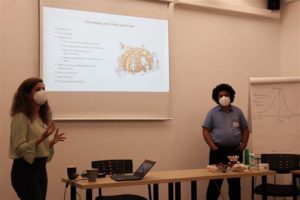 What would be the most useful benefits in the medical field in the near future as a result of AI neuroscience research?
What would be the most useful benefits in the medical field in the near future as a result of AI neuroscience research?
AJN: AI neuroscience research has the potential to bring several benefits to the medical field in the near future. Based on the significant progress in AI neuroscience, I believe that we can achieve in the near future the goal of broadly using techniques to develop personalised treatments in clinical fields. This development would help us with screening, early detection and diagnosis and personalised treatment programmes for patients based on different characteristics and types of data we collect, which in the end would help patients receive timely treatment and improve their outcomes. AI neuroscience research is also contributing to the development of brain-computer interfaces, which can allow people with paralysis or other disabilities to control prosthetic limbs or communicate using their thoughts. This is what attracted me a few years ago, when I decided to start learning and deepening my knowledge and skills in basic neuroscience research, driving me to learn and use computational modeling and tools. These skills are necessary for us researchers in interdisciplinary neuroscience and can help us soon in the early detection of conditions, for example in neurodevelopmental and psychiatric disorders, which would also contribute to developing rehabilitation programs and their efficiency. In this line, I have been looking at the neurobehavioral patterns in neurodevelopmental disorders compared to healthy brains or other diagnoses. Overall, AI neuroscience research holds great promise for improving our understanding of the brain in both healthy and unhealthy individuals and developing new treatments and therapies for neurological and psychiatric disorders.
Do you envision developing future projects related to the use of virtual tools in neuroscience?
AJN: Yes, of course. I would continue developing both virtual and physical tool-use paradigms used in our previous and current studies as well as looking at multisensory perception and body representation in the virtual body using augmented reality and neuroimaging techniques.
You attended the FENS Forum 2018, where you had poster presentations. What were the most memorable moments you took home after the event?
AJN: Some of the most memorable moments from the Berlin Forum may have included keynote speeches by prominent neuroscientists, the opportunity to learn about new research in the field, and the chance to connect with other scientists and researchers from around the world. Besides all the wonderful interactive experiences and explorative communication with international neuroscience researchers, my wife and I won a gift after answering neuroscientific questions in the exhibition hall. We still have it as a souvenir of FENS Forum 2018, as we kept it with us while relocating to three different countries since then. It serves as a reminder of our first attendance at a high-level interdisciplinary conference in Europe, with amazing people and fantastic learning and networking opportunities!
During the FENS Forums 2020 and 2022, you were selected to be a Social Media Ambassador and disseminated information about the events. How was the experience?
AJN: While being a Social Media Ambassador for both FENS Forums 2020 and 2022, I’ve learned a lot from different neuroscientists and I developed good friendships with international researchers both in-person and virtually, during the 2020 edition. The experience in Paris was really incredible, coming after the Covid-19 pandemic. I could enjoy the days of the Forum with my old and new friends.
Those experiences were very unique and now I have several wonderful friends, with whom I sometimes come into contact on a daily basis.
Why should neuroscientists want to become FENS Forum Social Media Ambassadors?
AJN: I highly encourage researchers to experience being Social Media Ambassadors within the context of the FENS Forum. This role is a great opportunity not only for the unique experience of building a sense of community and networking, but also for developing soft skills along with collaborating within an amazing multidisciplinary team and the Communications team of the FENS office. I believe that this opportunity is rare in other contexts, especially in large-scale events, with numerous participants. Additionally, by attending conferences such as the Forum we learn about new research techniques and approaches, all of which can prove valuable in advancing one’s career in neuroscience.
About the FENS Forum
The FENS Forum of Neuroscience is the largest international neuroscience meeting in Europe, occurring biennially on even years and covering all fields of neuroscience research from basic to translational. The FENS Forum 2024 will bring together experts in all fields of neuroscience to take us to the forefront of our current understanding of modern brain science. It will take place on 25-29 June 2024 in Vienna, Austria.
About the Federation of European Neuroscience Societies (FENS)
Founded in 1998, the Federation of European Neuroscience Societies is the main organisation for neuroscience in Europe. It currently represents 44 national and single-discipline neuroscience societies across 33 European countries and more than 22,000 member scientists. Discover FENS and subscribe to our biweekly News Alert, with information on our latest calls and activities.